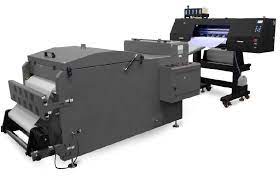Direct-to-film (DTF) printing has become increasingly popular in the realm of garment decoration. This innovative printing method offers versatility, durability, and vibrant colors, making it a preferred choice for many businesses and hobbyists alike. However, diving into the world of DTF printing requires some essential equipment and materials. In this blog post, we’ll explore the key components needed to start DTF printing and delve into why each one is crucial for success.
Contents
DTF Printing
At the heart of DTF printing lies the DTF printer itself. Unlike traditional methods like screen printing or direct-to-garment (DTG) printing, DTF printing requires a specialized printer capable of handling the unique process. DTF printers are designed to transfer designs from a printed film onto various fabrics with precision and efficiency. When choosing a DTF printer, factors such as print quality, speed, and compatibility with different films should be considered to ensure optimal results.

DTF Ink
DTF ink is specifically formulated for use in DTF printing applications. Unlike traditional inks, DTF inks are designed to bond with both the film and the fabric, creating a durable and vibrant print. These inks come in various colors, including CMYK and white, allowing for full-color printing on dark and light-colored fabrics alike. It’s essential to use high-quality DTF inks to achieve sharp, long-lasting prints that resist fading and washing.
Printable Film
Printable film, also known as DTF film or release paper, serves as the medium for transferring designs onto fabrics. This film features a special coating that allows the DTF ink to adhere to it during printing. After printing, the film is applied to the fabric using a heat press, where the ink is transferred from the film to the garment. Printable films come in different sizes and thicknesses to accommodate various printing needs, and they play a crucial role in determining the quality and durability of the final print.
Heat Press
A heat press is an essential piece of equipment for transferring designs from the printable film to the fabric. During the heat transfer process, the heat press applies heat and pressure to ensure proper adhesion of the ink to the garment. It’s important to use a high-quality heat press with precise temperature and pressure controls to achieve consistent results across different fabrics and designs. Additionally, the size of the heat press should be chosen based on the size of the prints and the volume of production.
RIP Software
Raster Image Processor (RIP) software is used to prepare designs for printing and optimize color output. DTF printing involves printing the design onto the printable film in reverse, so it appears correctly when transferred onto the fabric. RIP software allows users to adjust colors, sizes, and other parameters to ensure accurate and vibrant prints. Some RIP software also includes features for color management, halftone settings, and advanced image processing, making it indispensable for achieving professional-quality results in DTF printing.
Pretreatment Solution (Optional)
For printing on dark-colored fabrics or materials with low fabric content, a pretreatment solution may be necessary to ensure proper ink adhesion and washability. Pretreatment solution is applied to the fabric before printing, creating a base layer that helps the DTF ink bond securely to the surface. While not always required, pretreatment solution can significantly improve the quality and durability of prints on challenging substrates.
Conclusion
DTF printing offers an exciting and versatile alternative to traditional garment decoration methods. By investing in the right equipment and materials, businesses and individuals can unlock endless creative possibilities and produce high-quality, customized apparel with ease. From specialized printers and inks to printable films and heat presses, each component plays a vital role in achieving optimal results in DTF printing. Whether you’re starting a new printing venture or expanding your existing capabilities, having the right tools and knowledge is essential for success in this dynamic industry.



